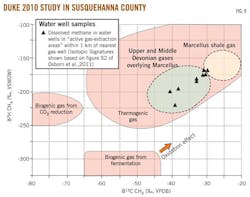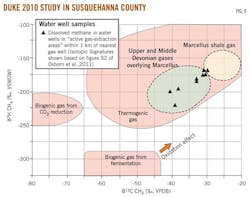P. 7 ~ Continued - Methane in Pennsylvania water wells unrelated to Marcellus shale fracturing
Displaying 7/10
View Article as Single page
Available information indicates this water well was drilled to a deeper depth of 175 ft into sandstone of the underlying Catskill formation. The presence of thermogenic methane in wells installed in the deeper Catskill sandstones is supported by data from the other 11 water wells sampled for isotope analyses by the Pennsylvania DEP and Cabot (Table 2), all of which appear to penetrate the Catskill formation and contain methane with isotopic compositions consistent with a thermogenic source.
As noted above, the isotopic signatures of the dissolved methane samples plotted in Figs. 6 and 7 fall within the range of isotope values consistent with an Upper or Middle Devonian source overlying the Marcellus, as established by the Pennsylvania DEP.
Hypothetically, a similar isotopic signature could be created by a mixture of Marcellus shale gas with methane from other sources, i.e., shallower Devonian gases and-or biogenic methane. Nevertheless, an assumption that Marcellus shale gas is the primary source of the thermogenic gas observed in these water wells is not supported by other lines of evidence in this region. Principally, historical and geological documents suggest that gases in the Catskill formation, which contains extensive fracture networks and is the primary water-bearing aquifer tapped by local water wells, are a more likely source.
Review of Duke University 2011 study
In 2010, Duke University researchers sampled 18 water wells in Susquehanna County to determine whether fracturing fluids or methane gases from deep shale gas formations had impacted shallow groundwater aquifers.1
The paper presented dissolved gas concentrations for all 18 water wells and carbon and hydrogen isotopic data for 9 samples, as shown on a supplemental plot. Thirteen of the 18 water wells were in "active gas-extraction areas," defined by the Duke researchers as located within 1 km or less of the nearest gas well, and five of the water wells were in "nonextraction" areas, defined as greater than 1 km away from the nearest gas well.
The researchers reported that methane concentrations in "active gas-extraction areas" were significantly higher than those in "nonextraction" areas. Isotope and compositional analyses of these elevated methane concentrations indicated the geochemical fingerprint to be consistent with a "thermogenic" gas source.
Within water wells located in "nonextraction" areas, average methane concentrations were reported to be lower than water wells located close to gas wells and the methane composition was predominantly of mixed thermogenic/biogenic origin.
Given the higher concentrations and thermogenic nature of methane in water wells proximate to shale gas wells, the Duke researchers asserted that hydraulic fracturing operations were facilitating the migration of deep thermogenic gas from the Marcellus and Utica shales into shallow drinking water aquifers in Susquehanna County. The study recommended increased monitoring and regulation of hydraulic fracturing operations to address such impacts.
The Duke study does not provide information regarding the locations of the sampled wells with respect to topography or the depths of the wells with respect to the Catskill formation. Therefore, we cannot evaluate their data with regard to these important factors. In addition, Duke only provides both δ13C and δ2H values only for wells in their active gas extraction areas in Susquehanna County, which does not facilitate characterization of the dissolved methane from water wells in nonextraction areas using these fingerprinting criteria.
However, comparison of the isotopic data presented in the Duke paper for wells in active gas-extraction areas to the isotopic gas characterization defined by Pennsylvania DEP and Cabot shows that eight of the nine water wells exhibit an isotopic signature consistent with thermogenic methane from the Upper or Middle Devonian deposits overlying the Marcellus shale (Fig. 9).
These data suggest that shallower Upper and Middle Devonian gases could account for the methane in the majority of the Duke water well samples without any contribution from Marcellus gas or the related hydraulic fracturing operations. At a minimum, given the similar signatures of shallower Upper/Middle Devonian gases and Marcellus shale gas, the conclusion of the Duke study that the thermogenic methane observed in these water wells was consistent with a Marcellus source was premature.
Displaying 7/10
View Article as Single page

